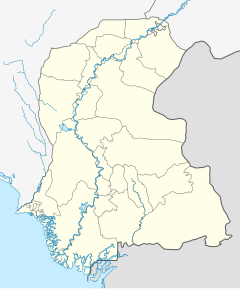
Back تفجير سيهون 2017 Arabic ২০১৭ লাল শাহবাজ কালান্দারের মাজারে বোমা হামলা Bengali/Bangla Atentado de Sehwan de 2017 Spanish بمبگذاری انتحاری ۲۰۱۷ سیهون Persian Attentat du sanctuaire de La'l Shahbâz Qalandar French 2017 सेहवन आत्मघाती बम विस्फोट Hindi Ահաբեկչություն Սեյվանում (2017) Armenian Bom bunuh diri Sehwan 2017 ID ഷെഹ് വാൻ ചാവേർ സ്ഫോടനം 2017 Malayalam Zamach w Sehwanie (2017) Polish
| 2017 Sehwan suicide bombing | |
|---|---|
| Part of Terrorism in Pakistan | |
 An interior view of Lal Shahbaz Qalandar's shrine in 2014. | |
| Location | Sehwan Sharif, Sindh, Pakistan |
| Date | 16 February 2017 |
| Target | Sufi pilgrims |
Attack type | Suicide bombing |
| Weapons | Suicide jacket,[1] grenade[2] |
| Deaths | 91 (+1 bomber)[3][4][5][6][7] |
| Injured | 300+[8][9] |
| Perpetrators | |
| Assailants | 1 suicide bomber |
On 16 February 2017, a suicide bombing took place inside the Shrine of Lal Shahbaz Qalandar in Sehwan, Sindh, Pakistan, where pilgrims were performing a Sufi ritual after the evening prayers.[2][10][11] At least 90 people were killed and over 300 injured.[3][8][12][13][14]
The Islamic State of Iraq and the Levant – Khorasan Province claimed responsibility for the bombing.[10] Services at the shrine were resumed the next day in an act of defiance against terrorists,[15] while leading Pakistani performers partook in the traditional Sufi whirling dance at the shrine a few days later as a protest against the radical Islamist perpetrators.[16]
The attack followed a series of terrorist incidents earlier in the month, including a suicide attack in Lahore. Pakistani authorities alleged that the attacks were orchestrated by jihadists in Afghanistan.[17]
- ^ Cite error: The named reference
GeoRajawas invoked but never defined (see the help page). - ^ a b Cite error: The named reference
dawn/16feb2017was invoked but never defined (see the help page). - ^ a b "Sehwan blast: Death toll reaches 90 as two more victims succumb to injuries". Geo News. 20 February 2017. Retrieved 25 February 2017.
- ^ "PM Nawaz, army chief visit Sehwan as death toll rises to 88". Express Tribune. 16 February 2017. Retrieved 18 February 2017.
- ^ "Death toll in attack on Lal Shahbaz Qalandar shrine rises to 83". Dunya TV. 16 February 2017. Retrieved 20 February 2017.
- ^ Zaidi, Mubashir (16 February 2017). "Pakistan cracks down on militants as blast toll rises". The Hindu. Retrieved 18 February 2017.
- ^ Latief, Samiya (16 February 2017). "Sehwan blast: 100 killed in suicide attack at Sindhs Shahbaz Qalandar shrine; Pakistan-Afghanistan border shut". India Today. Retrieved 17 February 2017.
- ^ a b "88 dead, 343 injured in Sehwan shrine explosion: official data". Daily Times (Pakistan). 17 February 2017. Retrieved 25 February 2017.
- ^ "Over 70 martyred in suicide attack at shrine of Lal Shahbaz Qalandar". The International News. Retrieved 16 February 2017.
- ^ a b "Explosion inside Lal Shahbaz Qalandar shrine in Sehwan; at least 50 dead". Express Tribune. 16 February 2017. Retrieved 16 February 2017.
- ^ "At least 72 killed in Lal Shahbaz Qalandar shrine blast". Samaa TV. 16 February 2017. Retrieved 17 February 2017.
- ^ "57 killed as suicide bomber hits Lal Shahbaz Qalandar's shrine in Sehwan". ARY News. 16 February 2017. Retrieved 16 February 2017.
- ^ "Blast tears through shrine in Sehwan, at least 50 dead". The Nation. 16 February 2017. Retrieved 16 February 2017.
- ^ "At least 72 martyred in bombing at Lal Shahbaz Qalandar shrine". Geo News. 16 February 2017. Retrieved 16 February 2017.
- ^ "37 terrorists killed in security crackdown after Sehwan bombing". The News. 17 February 2016. Retrieved 21 February 2017.
At 3.30 am the shrine's caretaker stood among the carnage and defiantly rang its bell, a daily ritual that he vowed to continue, telling AFP he will "not bow down to terrorists".
- ^ "Pakistani artists perform dhamaal at Sehwan shrine after suicide attack". HIndustan Times. 21 February 2017. Retrieved 22 February 2017.
Kermani told reporters the idea behind her dance "was to tell the perpetrators of terrorism that nobody can stop dance and music. These are part of our heritage, our culture." The artist said she intended to perform 'dhamaal', the ecstatic spiritual dance which the saint used to perform in his life.
- ^ "Pakistan asks Afghanistan to handover 76 terrorists immediately". Express Tribune. 17 February 2017. Retrieved 17 February 2017.

